Welcome to the Ultimate
Music Theory Worksheet Guide
The definitive handbook for the effective use of theory worksheets–with engaging companion activities and over 50 free printables that make learning theory fun.
How to get started:
1. Click play to see a quick overview of the resources in the guide.
2. Scroll down to read the Ultimate Guide. To print any of the 50+ worksheets for free, just click on an image.
3. Apply the active learning ideas. Double the effectiveness of each printable by utilizing the fun companion activities described below.
View a specific category by clicking on any of the quick links below:
- Note Names
- Intervals
- Circle of Fifths
- Rhythm
- Piano
- Scales and Chords
- Music Symbols
- Steps
- Music Alphabet
- Holiday
The Ultimate Music Theory Worksheet Guide
1. Note Names
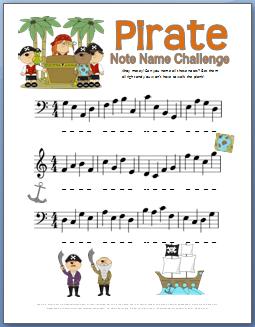 The ability to quickly identify notes is critical for playing music and is a foundational skill for all future music theory studies. But learning the note names can take a long time–students are essentially learning a new language. In each lesson, dedicate time for learning note names and consider sending home assignments.
The ability to quickly identify notes is critical for playing music and is a foundational skill for all future music theory studies. But learning the note names can take a long time–students are essentially learning a new language. In each lesson, dedicate time for learning note names and consider sending home assignments.
Help your new beginners master the notes as quickly as possible, and you’ll see that kids learn new pieces easier and with less frustration. This increases their satisfaction with your instruction and boosts their confidence. It’s true that time is a precious commodity during a lesson, but reserving time for note reading is worth every second! Read on for fun free music theory printables and ideas for applied learning activities that teach note identification.
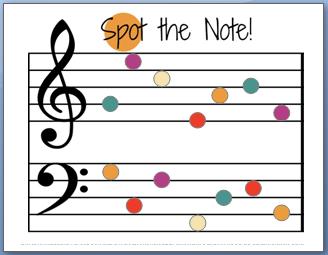 Spot the Note is a favorite printable because there are a ton of activities you can do with just this one sheet. Here are three fun ideas to get the cogs turning in your creative teacher brain!
Spot the Note is a favorite printable because there are a ton of activities you can do with just this one sheet. Here are three fun ideas to get the cogs turning in your creative teacher brain!
1.The first activity is to simply print it out and have your students write the name of each note inside the colored circle.
2. Use the printable to play a game. Give your students a copy of the worksheet and a handful of small candies like M&M’s. Call out a note name and ask your students to place a candy over the correct note. At the end of the game, students get to eat all the candies. This game works well both as a group game or in a private lesson.
3. You can also use this printout to give kids extra practice with the stem rules. Hand them the worksheet and ask them to add stems to all the notes. Turn it into a fun manipulative exercise by giving your students yarn or pretzel sticks that they can use to add the stems. I guarantee they’ll have a ball with this easy activity for your hands-on learners.
Group classes optimize your studio and give your students a fun and motivating learning environment. Click here to sign up for my newsletter and get your 2 free group lesson games.
I designed Bubble Notes with new beginners in mind. When you’re working with students who are just being introduced to the notes on the staff, you’ll want to give them extra note identification practice, but they’ll feel overwhelmed if you hand them a standard note name worksheet. This worksheet only has treble notes middle C through G and the top notes of the bass staff, which are typically the first notes a beginner pianist learns in her method books. This worksheet has a fun them that’s appealing to young kids and they enjoy writing their answers inside the bubbles.
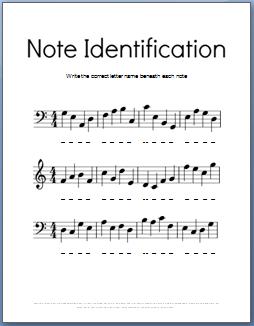 I’ve created a few black and white note identification worksheets that are ideal for use with older students or by teachers without access to a color printer.
I’ve created a few black and white note identification worksheets that are ideal for use with older students or by teachers without access to a color printer.
Remember that it is important to give your music students many frequent opportunities to practice note names. Practice note identification at every lesson with new beginners. If you have any students who are far along, but seem to struggle with some notes, I encourage you to pause and make time for reviewing note names. You’ll see dramatic improvement in their abilities and in their attitude towards music lessons. I’ve created quite a few note name activities, and I encourage you to utilize them to help kids master the notes as soon as possible. Their music studies will be much easier as soon as they do!
Try it today:
2. Music Intervals
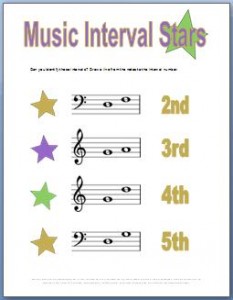 If you’re like me, you’ll be using the activities in this section all the time. You want your students to be good sight readers, and helping them with interval recognition is key to their success.
If you’re like me, you’ll be using the activities in this section all the time. You want your students to be good sight readers, and helping them with interval recognition is key to their success.
I made Music Interval Stars for kids who are just getting introduced to music intervals. Keep in mind that you can start introducing intervals even to very young students. We sometimes think we need to wait, but it’s really not necessary. I’ve seen five year old kids quickly become proficient, and it puts them on a super fast track for reading music.
Here’s how I like to introduce intervals. I first show simple examples–the Music Interval Stars worksheet works great. We learn how to count the lines and spaces to give the interval a name. We’ll practice this for several weeks until I feel like the kids have a sound understanding of how intervals are classified by size. Then we’ll started working on rapid identification by sight (without counting lines and spaces).
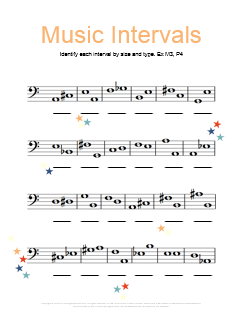
 For your more advanced students, you can use the theory printables to your right to help them identify music intervals by size and type. So instead of just writing “Fourth” they will write “Perfect Fourth”, or “P4”.
For your more advanced students, you can use the theory printables to your right to help them identify music intervals by size and type. So instead of just writing “Fourth” they will write “Perfect Fourth”, or “P4”.
Fun Ideas for Active Learning:
Now let me share with you a great interval activity that will help your students with ear training and help them better understand how music works: Print out one of these worksheets and have your student identify all the intervals. Then highlight three or four of them and ask your student to play the notes and describe the sounds. First play the notes melodically and then harmonically. Ask leading questions to help your student get really specific in describing the characteristics of the sound. Does it sound happy or sad? Calm or tense? Do you think these notes could be used to end a song, or does it sound like the notes need resolution?
Here’s one more activity that will help your students really internalize these intervals. Ask your students to go home and compose a short song that contains all of the intervals you highlighted and discussed on the worksheet. Before turning them loose, you might help them analyze which of the intervals could be used for an interesting introduction, and which would give their piece a good conclusion. This simple activity will get you big results, and I encourage you to print out one of the worksheets today and try it with your students. You’ll be impressed by their creations and their retention of the material.
Try it today:
3. The Circle of Fifths
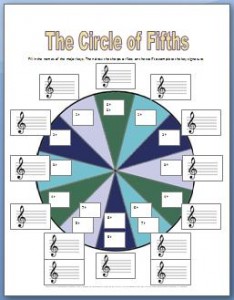 No collection of music theory exercises would be complete without a circle of fifths worksheet. The circle of fifths is an essential tool for students learning the number of sharps or flats in each key. The circle of fifths becomes even more important when students begin creating their own music because it provides a quick visual representation of the way chords flow.
No collection of music theory exercises would be complete without a circle of fifths worksheet. The circle of fifths is an essential tool for students learning the number of sharps or flats in each key. The circle of fifths becomes even more important when students begin creating their own music because it provides a quick visual representation of the way chords flow.
This particular printable is one of the most popular music theory worksheets on my website. It’s also one of my personal favorites because music students get to practice two important concepts that go hand in hand. To complete the worksheet, students first go around the circle and write the name of each key. Then students can go back through and practice writing the sharps and flats to complete each key signature. You can remind them to pay special attention to the correct placement of the sharps and flats. Give your students a new copy of this worksheet about every other month and before long they’ll be pros at using the circle of fifths and key signatures.
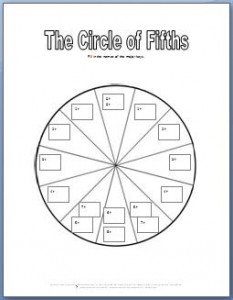 If you’d like a more basic circle of fifths worksheet, print the one featured on the right. Students just look at the number of sharps or flats listed and then write in the name of the corresponding key. After they have completed the exercise, take the time to help them understand the application of the circle of fifths. Discuss how it helps us quickly identify the key signature at the beginning of a piece and how it helps us understand cadences and chord progressions.
If you’d like a more basic circle of fifths worksheet, print the one featured on the right. Students just look at the number of sharps or flats listed and then write in the name of the corresponding key. After they have completed the exercise, take the time to help them understand the application of the circle of fifths. Discuss how it helps us quickly identify the key signature at the beginning of a piece and how it helps us understand cadences and chord progressions.
Once completed, either of these printables can be used to play a game called “Dizzy Keynote Frenzy”. Sit near the piano and all you need is the printout, a marker, a die, and a token for each player. Place all tokens on the same wedge and player 1 rolls the die and moves that number of spaces around the circle. The student then has 30 seconds to play the keynote that corresponds to that section of the circle. If she answers correctly, she gets to write her initials in the space. The next player then takes a turn to roll the die. If his token lands on a space that already has initials, he looses that turn. Play continues until every wedge has a set of initials. The player who initialed the most sections of the circle of fifths wins.
I created a couple more variations on these activities so that you can find the one that best fits your goals for teaching your students. There are black and white copies for teachers who have a large class and can’t afford colored printing. There are music worksheets that focus on treble clef key signatures and others that focus on bass clef key signatures so that you can help your students become proficient with both clefs–especially when it comes to writing the sharps and flats on the correct line or space. To see these printables, visit circle of fifths worksheets.
Try it today:
4. Rhythm Worksheets
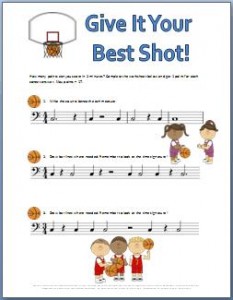 Print out Give It Your Best Shot and use it alongside a fun run around activity to get your students off the bench for a couple minutes. They’ll love the change of pace, and when you include activities like this your students really look forward to coming to lessons.
Print out Give It Your Best Shot and use it alongside a fun run around activity to get your students off the bench for a couple minutes. They’ll love the change of pace, and when you include activities like this your students really look forward to coming to lessons.
Grab the printed worksheet, a basket and three beanbags or small balls. Hand your student the worksheet and ask him to give it his best shot and see if he can get a perfect score. Tell him that if he gets a perfect score, he’ll get to try his hand at scoring points with a real basket.
This music worksheet covers these rhythm topics:
If the student misses an answer or two, help him understand how to get the correct answers and then let him have a turn tossing the beanbags or balls into the basket. Your student will have a blast and will probably remember this rhythm lesson years later!
Most rhythm worksheets can be used to help kids internalize rhythm. At every lesson I have my students tap and vocalize rhythm and I’ve seen tremendous improvement in their sightreading abilities since implementing this strategy. You can do the same with your students by asking them to tap the rhythms on the worksheets with you. Add some variety by asking them to tap on a drum or tambourine.
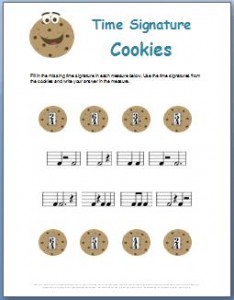 A great way to help kids understand time signatures is to have them look at a measure and then decide what time signature should be used with that measure. Time Signature Cookies gives kids practice doing just that!
A great way to help kids understand time signatures is to have them look at a measure and then decide what time signature should be used with that measure. Time Signature Cookies gives kids practice doing just that!
Each cookie displays a time signature that matches one of the example measures. You can have your students draw a line from the cookie to the correct measure, or you can ask them to write in the time signature for each measure. I usually prefer to have them write it in, just because I think it’s good practice for students.
If you have any students who miss several answers, go through the assignment with them and help them write the counts beneath each note or rest. I had one student who kept missing these until I finally discovered wasn’t giving the rests any beats.
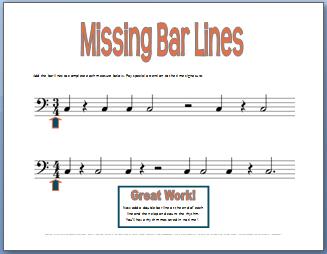 Missing Bar Lines helps kids understand how music is organized into measures. The bar lines are missing, so students look at the time signature and count the beats to add the missing bar lines. When they’ve completed the worksheet, you can have them clap and count the rhythm.
Missing Bar Lines helps kids understand how music is organized into measures. The bar lines are missing, so students look at the time signature and count the beats to add the missing bar lines. When they’ve completed the worksheet, you can have them clap and count the rhythm.
Turn this worksheet into a fun manipulative activity by giving your students pull-apart licorice or pretzel sticks. They can use the snacks to add the bar lines. They’ll be extra motivated to do their best if you tell them that they get to eat the snacks after they’ve correctly completed the exercise!
Try it today:
5. Piano Worksheets
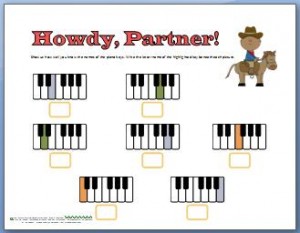 The activities in this section are specific to the piano. Kids love the cowboy theme on this keyboard printable, and it’s super easy to use. Just print it out and have your piano students write the name of each highlighted key. With young students, always ask them to tell you if the highlighted key is near a black key or a white key. This will speed up their mastery of the names of the keys.
The activities in this section are specific to the piano. Kids love the cowboy theme on this keyboard printable, and it’s super easy to use. Just print it out and have your piano students write the name of each highlighted key. With young students, always ask them to tell you if the highlighted key is near a black key or a white key. This will speed up their mastery of the names of the keys.
Fun Ideas for Active Learning: After completing the worksheet, ask kids to find and play each note on the piano. Or give the child a handful of blue, green, and orange beads and ask him to place a bead on the piano key that matches the highlighted keys on the printable. Have him name the key each time he places a bead.
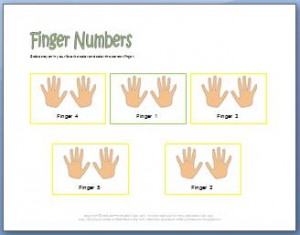 If you work with young students, you know that they need a lot of practice to learn which number goes with each finger. Print out this worksheet and then let your students grab a crayon in their favorite color. Then just help your students color the finger that goes with the number listed beneath the hands.
If you work with young students, you know that they need a lot of practice to learn which number goes with each finger. Print out this worksheet and then let your students grab a crayon in their favorite color. Then just help your students color the finger that goes with the number listed beneath the hands.
Fun Ideas for Active Learning: Point to a number on the worksheet and ask your student to play a white key with that finger. Then point to another number and ask the child to play a black key with the correct finger. There are a lot of variations if you ask for right hand or left hand, or if your students know the names of the keys and you call out a finger number and the letter name of a key. For more music theory printables that are specific to the piano, see piano worksheets
Try it today:
6. Scales and Chords
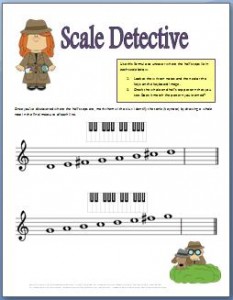 Use these music worksheets to help kids understand the whole and half step pattern used to form major scales. When students understand the formula, they can play all the major scales and they can begin a more in depth analysis of the tonality within a key.
Use these music worksheets to help kids understand the whole and half step pattern used to form major scales. When students understand the formula, they can play all the major scales and they can begin a more in depth analysis of the tonality within a key.
Scale Detective lets kids imagine that they are detectives searching for the clue to how scales are formed. I love that the worksheet includes a keyboard diagram above the notes of the scale. This diagram is especially helpful for beginners who may not yet be able to quickly identify whole and half steps while viewing music notation. But when you relate those notes to the keyboard, it’s easy as pie to see where the half steps are.
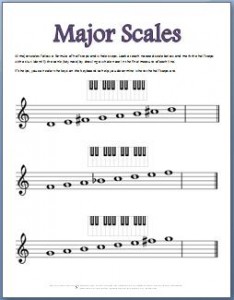 I also created a version for older students that’s got three scales for them to analyze and can be printed in black and white without the cartoons. They can refer to the piano keyboard diagram if needed to mark the half steps on the scale. There’s also a place for them to write in the tonic.
I also created a version for older students that’s got three scales for them to analyze and can be printed in black and white without the cartoons. They can refer to the piano keyboard diagram if needed to mark the half steps on the scale. There’s also a place for them to write in the tonic.
Scales help us understand how one note relates to another within a key, so I encourage you to have your student practice playing scales and know the theory behind how they are formed with half steps and whole steps. Click on the image to the right to print the older student version of the major scales activity.
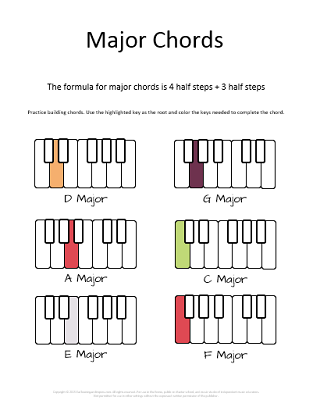 Another element that we spend a ton of time on in my studio is chords. When students have a solid understanding of chords–how to play them, how to build them and how to recognize them in their pieces, everything gets easier! When reading music, beginner students will often read individual notes, which makes practice cumbersome and time consuming. But if a student knows chords well, the amount of time required to learn a new piece is significantly reduced.
Another element that we spend a ton of time on in my studio is chords. When students have a solid understanding of chords–how to play them, how to build them and how to recognize them in their pieces, everything gets easier! When reading music, beginner students will often read individual notes, which makes practice cumbersome and time consuming. But if a student knows chords well, the amount of time required to learn a new piece is significantly reduced.
Chords are also a super easy way to harmonize a melody when kids make up their own songs or want to embellish a simple piece. Teach kids the formula for building chords, and they’ll be able to play any chord they need. The worksheet featured here helps kids master the formula for building major chords. The half step formula is listed at the top of the page and students just color in the keys needed to complete each chord. This is one of my favorite music theory worksheets to use with older beginners. I like to help them learn their chords as quickly as possible so that they can start having fun with piano improv. And the older students really appreciate this–they’re excited to be able to start making their own impressive music after only a few lessons.
Try it today:
7. Drawing Music Symbols
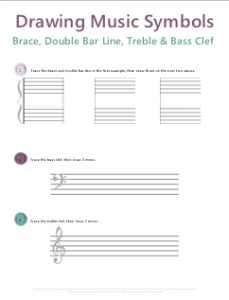 There comes a time in every student’s musical education when they need to learn how to draw the music symbols. I find it interesting that some students can see these symbols every day for years, but don’t seem to really see them. I’ve asked a student to draw a brace and had them draw it on the far right of the staff!
There comes a time in every student’s musical education when they need to learn how to draw the music symbols. I find it interesting that some students can see these symbols every day for years, but don’t seem to really see them. I’ve asked a student to draw a brace and had them draw it on the far right of the staff!
This worksheet will help your students pay attention to the details of the symbols and learn how to draw them correctly. Students first trace and then draw the brace, double bar line, bass clef, and treble clef. I’ve found that student are much more confident when then first get to trace the element. Then when they immediately draw it free hand much more accurately.
But don’t get me wrong! The first time students draw a brace or a clef it will look wacky. But with practice they’ll get better. And as your students begin composing their own songs or writing down a little ditty that they’ve improvised, they’ll be able to do so because you took the time to teach them how to draw these symbols.
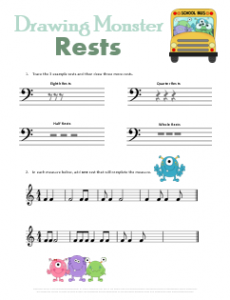 Other symbols that I’ve noticed students can have a hard time drawing are the rests, so I’ve added this fun Drawing Monster Rests worksheet here. Students often mix up the half and whole rests, and when they draw them it helps kids to better be able to distinguish the two when they are reading their sheet music.
Other symbols that I’ve noticed students can have a hard time drawing are the rests, so I’ve added this fun Drawing Monster Rests worksheet here. Students often mix up the half and whole rests, and when they draw them it helps kids to better be able to distinguish the two when they are reading their sheet music.
The biggest monster for most students, however, is the quarter rest. That little squiggly line can cause a lot of frustration for kids. I like to have my students trace it, and then when they freehand I tell them that it looks kind of like a “Z” with a tail. These instructions seem to help and it’s fun to see kids improve as they continue to practice drawing music symbols.
8. Identifying Half Steps and Whole Steps
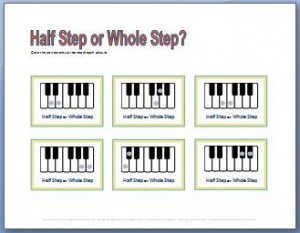 Help your students understand the difference between half steps and whole steps with these colorful printables. You’ll want them to have a clear understanding of half and whole steps before working on the major scale pattern and also when you delve into major and minor chords–and that’s where creating music really starts getting fun.
Help your students understand the difference between half steps and whole steps with these colorful printables. You’ll want them to have a clear understanding of half and whole steps before working on the major scale pattern and also when you delve into major and minor chords–and that’s where creating music really starts getting fun.
This first printable is based on the piano keyboard, which I think is the easiest way to introduce steps because it’s easy to visualize the steps on the keyboard. The activity is easy to use because kids just look at the highlighted keys and then circle their answer.
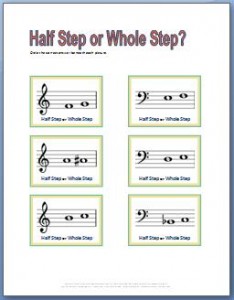
You might go one step further and ask your students to play the notes on the keyboard. Kids who are kinesthetic learners will especially benefit from playing and vocalizing the steps they see.
I recommend that you begin with the keyboard worksheet and then introduce this worksheet that has notes on the staff. This worksheet can be used to build a foundation before delving into the identification of music intervals by type.
Help kids complete this worksheet by having them sit at the keyboard and play the notes. With time, students will be able to identify the steps without sitting at the piano, but this is a great way to help them visualize the distance between the notes.
Try it today:
9. Treble Clef Notes and Bass Clef Notes
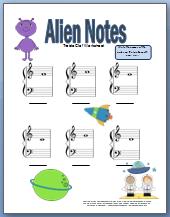 At times you may want to focus on just the treble clef or the bass clef, so I created a few worksheets that isolate each clef. If your students struggle to identify the higher notes on the treble staff, you can use a treble printable to provide extra practice. Click the link to see more treble clef worksheets.
At times you may want to focus on just the treble clef or the bass clef, so I created a few worksheets that isolate each clef. If your students struggle to identify the higher notes on the treble staff, you can use a treble printable to provide extra practice. Click the link to see more treble clef worksheets.
The most common issue I see is kids that are great with the right hand notes, but really struggle to identify bass clef notes. For whatever reason, kids always seem to need extra practice with those left hand notes, so you’ll want to visit eartrainingandimprov.com often to print bass clef worksheets like the one you see here. You can view all bass clef worksheets by clicking bass clef worksheets
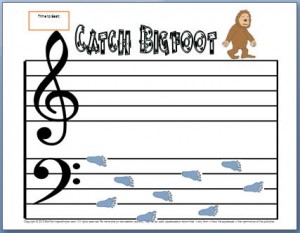 Do you have any older students who desperately need more practice with bass clef notes, but who resist those boring flashcards? Try this fun Catch Bigfoot activity. To play, you give students a time to beat in order to catch Bigfoot. They’ll have to quickly write in the names of the notes–and there is no time for counting lines and spaces, so they’ll have to identify the notes by sight!
Do you have any older students who desperately need more practice with bass clef notes, but who resist those boring flashcards? Try this fun Catch Bigfoot activity. To play, you give students a time to beat in order to catch Bigfoot. They’ll have to quickly write in the names of the notes–and there is no time for counting lines and spaces, so they’ll have to identify the notes by sight!
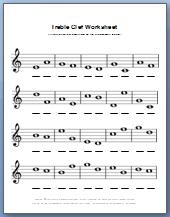
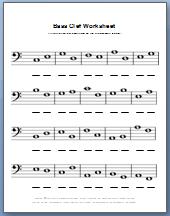 And of course, I haven’t forgotten that there are times when a black and white worksheet is more appropriate for a music teacher’s particular situation.
And of course, I haven’t forgotten that there are times when a black and white worksheet is more appropriate for a music teacher’s particular situation.
Click on an image to the left to print in black and white.
Try it today:
10. Rhythm Worksheets for New Beginners
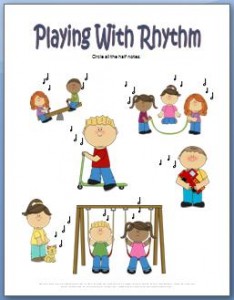 The worksheets in this section are very basic, which is ideal for young children. Revisit these introductory rhythm concepts often during the first few months of music study and your little students will have a solid rhythm foundation for their future studies. I’ve found that devoting time to rhythm in every lesson with new beginners results in significantly better sightreading down the road.
The worksheets in this section are very basic, which is ideal for young children. Revisit these introductory rhythm concepts often during the first few months of music study and your little students will have a solid rhythm foundation for their future studies. I’ve found that devoting time to rhythm in every lesson with new beginners results in significantly better sightreading down the road.
Do you have really young students who need extra reinforcement with rhythm basics? I created Playing With Rhythm especially for those little ones.
First review with your students what half notes and quarter notes look like. I usually point to a quarter note first and ask the kids to describe what it looks like. We conclude that it’s a black oval with a stem. Then I point to a half note and ask them to tell me what makes this note different from the first note. We conclude that it looks the same, except that it is “empty”.
Then play! Give kids this worksheet and ask them to “run around the playground” looking for all the half notes. Young kids think it’s fun to wander their pencil around this 2D playground and circle the half notes. And after they’ve identified over a dozen, they’ll confidently identify these rhythm notes next time they sit down with their method books.
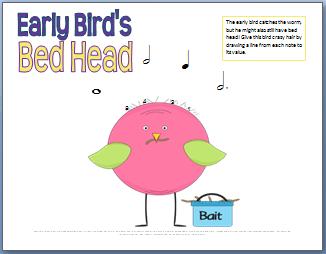
Early Bird’s Bed Head Rhythm Notes lets kids practice matching a rhythm note with its value. Kids just draw a line from the note to its numeric value. Your young students will have a blast if you give them bright crayons and encourage them to draw crazy, curly or zig zaggy hair.
Try it today:
11. Music Alphabet
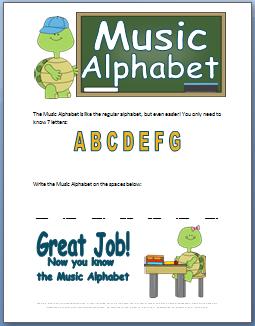 The music alphabet is among the most basic of music theory concepts. Your older students will nail it down within 5 minutes, but younger kids will need to practice through both written and oral review.
The music alphabet is among the most basic of music theory concepts. Your older students will nail it down within 5 minutes, but younger kids will need to practice through both written and oral review.
This first worksheet is for introducing the music alphabet. You can show them the print out and explain that the music alphabet is just like the regular alphabet, only easier because it has just 7 letters. Invite your student to point to each letter while you recite the music alphabet. Next, hand the child a pencil and ask her to copy the music alphabet onto the lines.
At the next few lessons, continue reviewing the music alphabet by asking the student to verbalize it with you and also write it down. When you think she’s got a good understanding, you’re ready to try this next worksheet.
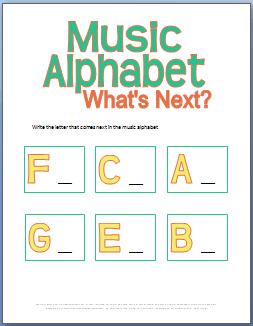 Use this worksheet to see if your students really do understand the music alphabet. Kids just look at each box and fill in the letter that comes next. The trickiest is the letter G–many students will write H. Remind them that A comes after G in the music alphabet.
Use this worksheet to see if your students really do understand the music alphabet. Kids just look at each box and fill in the letter that comes next. The trickiest is the letter G–many students will write H. Remind them that A comes after G in the music alphabet.
Either of this worksheets can be used with manipulatives. You can use alphabet letter tiles or beads and ask the student to place a bead of the correct letter on the black space. Adding this kind of variety to your lessons will help your students stay excited about piano.
Try it today:
12. Holiday Music Theory Worksheets
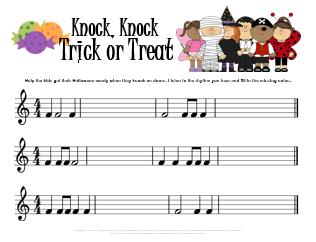 I just love holidays in the piano studio! Kids get super excited about the holiday events and the fun themes give us the perfect opportunity to explore new ways to learn and apply music theory.
I just love holidays in the piano studio! Kids get super excited about the holiday events and the fun themes give us the perfect opportunity to explore new ways to learn and apply music theory.
I’ve created lots of printables with holiday themes and will continue to add to more, so be sure to check back each time a holiday is approaching.
In addition to the worksheets, you’ll find tons of ideas for holiday-themed games that are perfect for private lessons and also activities that are a blast in a group lesson or music classroom. Just click a link or an image below to visit the pages for Halloween, Thanksgiving, Christmas, Valentine’s Day, Saint Patrick’s Day and Easter.
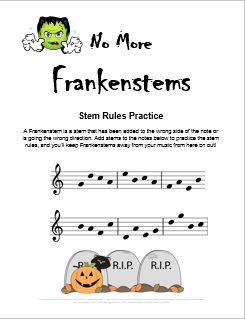
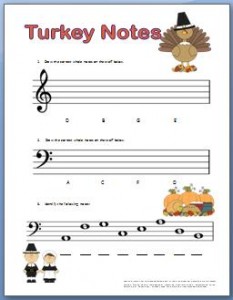
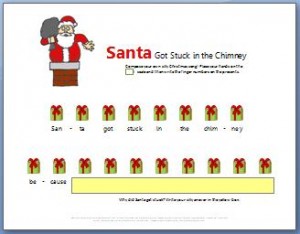
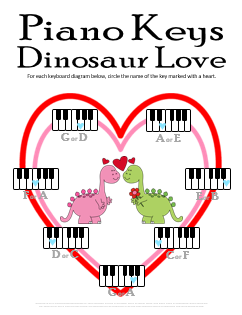
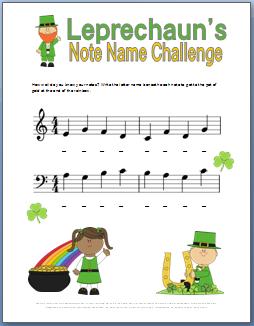
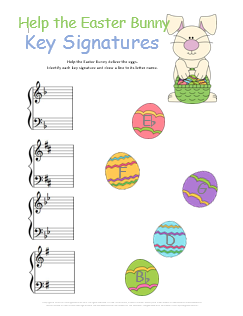
Did you enjoy the resources and teaching ideas in this music theory worksheet guide? Here’s what you can do next:
First, Leave a Comment–we all benefit when we work together and share ideas.
Which of these free printable music theory worksheets are your favorites? What other fun ideas do you have for teaching theory? Leave a comment below to help out the other piano teachers in our online community.
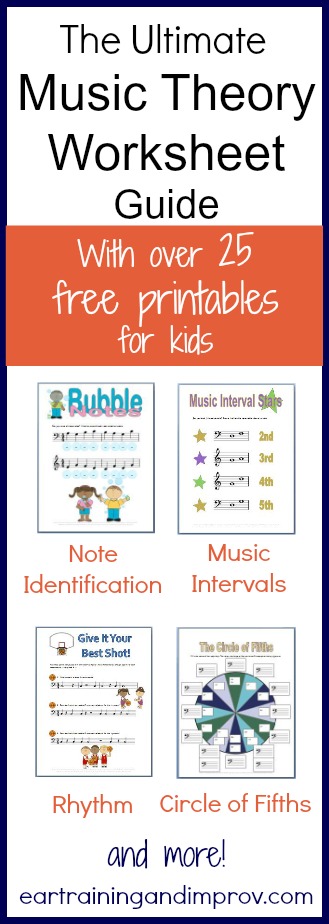
Second, Help Other Music Teachers find and use these music theory worksheets.
1. Pin the title image that’s on the right
2. Like and share myfunpianostudio.com on Facebook
Third, Start Teaching Group Classes to optimize your studio and give your students a fun and motivating learning environment.
Sign up for my email newsletter and get 2 free group lesson games that your students will love. Click the button below to subscribe and get the 2 free group games.

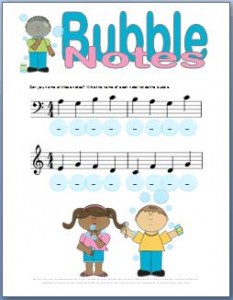
Thank you for this! My younger kids love doing worksheets with lots of bright colours like this!
Dear Kristen,
An SF Bay Area Piano Studio attempt to survive this Coronavirus Quarantine. Thanks for these worksheets during this time. These worksheets will complement my temporary online instruction for K12 after-school lessons.
Sincerely,
Gregory Smith
I REALLY LEARNT A LOT FROM YOUR WORKS SO FAR. INFACT WITH THIS EVERY CHILD WILL BE ABLE TO APPRECIATE THE LESSONS IN MUSIC
I’ve seen lots of students who are good at treble clef notes, but really struggle with the bass clef. I’ve tried asking parents to do flashcards at home, but it hasn’t really worked that well. I’m looking forward to trying your worksheets and these fun activities. Thank you!
Have I told you you’re awesome today? I think its fantastic how you create or find all these resources just to hook kids into music. As a public educator with very little resources, I love the free worksheets and activity ideas. Thank you!!!
Thanks Beth, Jenny and Heather. I’m glad you like the worksheets!
I know what you mean, Teri. Families are busy and aren’t always able to help their students get in the extra practice they need. We just do the best we can during lessons and that’s why quick activities like these are perfect!
Wow what a useful fun set of resources – thank you!
Wow, wow, WOW! Thank you so much! I have a new 5 year old starting tomorrow. Will laminate and use these. YOu made my day!!
You’re welcome, Kelly. I’m so glad you’ll be able to use these worksheets and activities with your new student.
Thanks so much! So cute and great tools for teaching!
Thanks, Diane. I’m glad you visited my little website and that you like the worksheets.
Thank you, Kristin, for a terrific site. I look forward to using these worksheets with my students. I think note names in general are hard for some students.
This is an awesome resource. I teach K-2 music and I can certainly utilize this information.
Thanks, Bobby! I hope you’ll get lots of use out of these activities!
Thanks so much for sharing these learning activities! I know several of my students who will love the cute pictures that somehow make worksheets more fun!
Thank you very much Kristin. They are very appreciated and my students will enjoy them. You are very kind!
This is awesome! Thank you so much for selflessly sharing these learning activities. Absolutely a helpful and fun way to learn music theories. Love it :)
Note reading will be the best ones. for me. Thank you for your generosity!
My students are going to love these colorful worksheets with fun graphics! Thank you!
You’re very welcome, Regina. Thanks for being so kind. Hope your students have a lot of fun!
Thank you so much for these fabulous worksheets!! It makes music theory cool to teach and learn. Your hard work is appreciated!
Thanks, Roberta! It really has been a lot of work, but it’s worth it when I hear that these resources are helping you make music theory fun to learn. I hope you’ll keep in touch!
wow, Im 57, has been teaching since 22! You think like I do! MUSIC HAS TO BE FUN!!! Not many music teachers in South Africa shares this attitude! I hope I can get these downloaded!
BC…..Before Computer!
Kind regards
Ilse
South Africa
Ilse, how wonderful that these worksheets are being used all the way in South Africa. It’s so fun that we can share ideas and help each other. Great job keeping the right frame of mind during so many years of teaching. You’re right, when music is fun, kids respond so much better. Your students are lucky to have you!
Thank you Kristin!
So kind and generous of you to make these worksheets and activities available to all. I can only imagine the time and effort you have put into all this!
With appreciation,
Peter
Thanks, Peter! It has been a lot of effort to make these, but worth it when they help kids make more progress and help other teachers save time on lesson prep. Thanks for your kind comment.
very very nice… Thank you
I loved it! I share all the comments about music theory being fun fun fun! As a cultural & Arts teacher I try to find ways to make Culture, Arts & Music a fun experience for my students. Music theory can be very challenging. Thank you for these awesome Ideas! My musical & warm greetings from sunny Happy Island Of Aruba!
Hi, I was struggling hard to teach my son (6yo) the music notes as I am not music trained. This site was an answered prayer! Thank You for your generous sharing for the spread of music education!! I teach mainly Visual Arts. Am very encouraged and inspired by blogs like yours and strive to give freely as well. Lots of Gratitude from the heart!
Angie, what a sweet comment. I’m so glad that these will help. And I’m super impressed that you’re teaching the notes to your son. Keep up your great work–giving your son a music education will enrich his life in so many ways and he’ll be so grateful for all the time and effort you’re investing to help him grow. What a wonderful mother you are!
I super love it. THANKS for the great help :)))))
Thanks Kesha! You’re super too–keep up your great work!
Thank you so much for these worksheets! My son has autism, visual processing disorder and dyslexia and has been taking piano lessons for almost one year. He has been making steady progress, but we are still having trouble learning the note names. Also each time a new concept is introduced, it is difficult for him to master it. These worksheets are a answer to prayer for us. They are visually spaced so well it is easy for him to see what he is supposed to be learning without the “extra fluff”! We are making more progress since we found them than we had before. He is truly enjoying learning the piano and this has given him such a much needed confidence boost. Thank you! Thank you!
Allison, thank you for taking the time to share your son’s progress. That is wonderful! It warms my heart to hear that something I created has played a small role in helping your son with his musical education. You’re a great mom for being so involved in his lessons and for giving him the gift of music.
Thank you for helping kids learn music. The are I live in doesn’t focus on music like when I was young. My kids are missing out on band and basics. This makes it easier for me to teach them to read music and appreciate it.
So glad these are helpful, Laura. You’re a great mom for filling in the gaps in your children’s education.
These resources are very useful. i’m very excited to use all of these in our workshop. It’s really a great help. Thank you very much Kristin for your very creative mind and generous heart to share all of your ideas with us. May God bless you always for thinking others.
Hi Kristin!
I love your site, and I use A LOT of your free printables for my students! I was wondering if you had any more worksheets on note values than listed here? Maybe some with time signatures or adding up the note values or creating rhythms. Thanks!
So glad that these worksheets are helpful! You’re right, I do need to get more rhythm worksheets uploaded. There are some scattered throughout the holidays, so anytime that you’re approaching a holiday, you can use those for the worksheets. But I’ll definitely need to add some more general use worksheets.
Thank you for making all of these great resources available! I will be starting to teach lessons this summer after a hiatus. I am excited to try these ideas with my new students!
Love your ideas. look forward to using more, just got a new 6yr old student
Terima kasih (Thank u) from Indonesia. This is my first year being a music teacher in a formal school. These worksheets help me a lot
Question. Do you have the answer keys to these worksheets? My kids take piano, but I don’t play. Their teacher wants them to practice note identification and I love these….but I have no idea if they are correct or not. Thank yo!!!
Thanks so much for these free printables!! I have a Life Skills music student who is moving to the far, far north of Canada where there is no school past Grade 8 (age 13 or so). He loves music and has perfect pitch, so I’m glad I was able to print some music worksheets for him to take along when he moves.
Thanks so much! You have really encouraged me to start a group pre-piano class. I have some fun games and ideas to get it going. I also do a lot with movement since I am a retired general music teacher so I feel confident I have enough to get started!
I am looking for a printable that I saw online yesterday. (But can’t find today!) it was a picture of an elephant with a bird on its head and a fly on the bird’s head. It was a fun way of illustrating the e,b,and f lines on the treble clef. Was this one on your printables?
Hi Debbie! Yes, a link to the printable can be found on the Treble Clef Worksheets page. Best wishes for you and your students!
Thank you so much for these worksheets! I’m glad that there are a variety of resources that I can use to make the lesson more interesting and meaningful for my younger students. I’ve only taught piano lessons for one year so things like this have really helped me get started and know how to teach my students.
Thanks for your kind comment! I’m so glad these are helpful and wish you and your students a great year.
Just found your website tonight while looking for resources to teach my children Music Theory for our homeschool. Thank you so much for developing and sharing all these pro tables and taking the time to explain how to use them! We will be using this resource a lot, and I will share it with others.
So glad these help! Good luck with your homeschooling!
Thank you
These music sheets will really help me on my test
Thank you so much! What a resource!
I was pleasantly surprised when I found these helpful, colourful and creative worksheets. Thank you so much!
Your site has great ideas for my special education students in middle school. They have just the right amount of examples to accommodate middle school students in my LIMMS classes! I loved them all! I only copied a few right now but perfect for my intervals, and scales lessons! Thank you so much! The students will love them. I can also leave these for a sub to use as well!
Jean, your kind comment made my day. I’m so happy to hear that these worksheets are helping your students. Keep up your great work!
These are fabulous. I teach chorus in a k-12 and i find them really helpful in my classes as well! great job on your website too!
You made these sheets right around when my baby was born and now she is 5 and using them. It’s amazing how your effort is still helping parents after many years and will continue to help. Thank you for this!
Oh how wonderful! Your comment made me smile, and I’m so happy that your daughter is enjoying these theory worksheets.
These worksheets are really great! I was asked to teach the little kids this year, and I didn’t have much fun stuff for them, so this is a wonderful find. I know it took a lot of work and time to put these together. Thank you so much!
Wow! Thank you so much, these worksheets and tips are amazing and so helpful when still finding your teaching feet.
So glad these ideas are helpful! I wish you big success!
I teach grades 1-9 and have found your worksheets extremely useful. They are set out very logically and the instructions are clear. Thank you for your hard work – it is truly appreciated.
Thanks Tessa! Keep up your great work with those students–they’re so lucky to have you!
I have been looking for something to add a little fun to my studio! This looks like just what I need!!!
thanks for the information
I teach piano from 6-13.
Your data is wonderful.
Thanks to you I think I can have a fun class with my children.
Thank for the data
Thank you fo these sheets!
Thank you so much for these wonderful worksheets which you offer for free on your website. I give piano lessons and they are very useful and also fun to help improve students’ music theory. I really appreciate your generosity! May God bless you and reward you for all the hard work you put into making them!
Greetings from Romania!
These are a lifesaver. Thank you.
Thanks!
Thanks alot – I was looking for things to give my students to print at home during coronavirus lockdown and a couple of these were perfect – the ball bouncing one is great cause it gives them something non-computer oriented to do.
Thanks so much!
Good info. Lucky me I recently found your website by chance (stumbleupon).
I have saved as a favorite for later!
Thank you so much for all the worksheets. Like most of the world, we are going though the COVID19 (corona virus) social distancing. In a time like this, I am thankful for your dedication to music, as we are unable to have our regular, face-to-face private piano lessons. These worksheets will really keep my students thinking, practicing, and enjoying music!
Thanks again!
This is a great resource for a mom who is unversed in piano herself but still trying to encourage her child’s interest and supplement the piano instruction at home. The activities are attractive and well thought out. We all benefit from your years of on-hand experience with youngsters and older students alike. Thank you very much for organizing it so well and for making it free! This mom and 6 year old are very grateful.
Thank you very much for the worksheets! I complied them and will put it in binder for my kids. Its a very big help especially during this pandemic! I love the cartoons too! Thank you again!
Thank you! I am doing assessments to start the year and was looking for ways to do this with my online lessons. Your wonderful worksheets fit the bill perfectly! I have downloaded almost all of them listed here. The students will love it – much more fun than just showing them flashcards and having them name notes, intervals, etc.
So grateful for what you have done here! This is a God-send! Blessings to you!
These are so creative! Thank you!
Your worksheets are fun and engaging! Thank you so much for providing some much needed resources for my Annual “Piano Practice Challenge” where students complete theory pages to reach their goal line.
I just found your website while looking for ideas to help a young student. Your worksheets and ideas, including the group activities, are amazing!!! Thank you SO much for sharing!!
Thank you for sharing all of this material. Very nice Work!
Thank you so much for these :) I teach piano to younger students and some of these sheets will be their Christmas ‘homework’! Thanks again
Thank you so much for these neat worksheets! I have some very young beginner pianists, & I need a little extra time & material to cover with them. I really appreciate your help!
Thank you so much for all these cute and colorful worksheets! I am a special needs kids’ teacher, and I am also teaching music to them. All these worksheets are very easy for them to understand. I really appreciate you made it all free and share it with everyone! God bless!
Thanks Jillian—that was so kind of you. I’m so glad these resources are helping the special needs kids you teach.
Thanks for sharing all these fun activity and ideas. Do you have the formula sheet for minor chords like you do for the major chords? I am also be interested in formula sheet for diminished and augmented chords. I’m willing to pay for them.
Thanks Janet for your kind comment and your question. I don’t have those worksheets right now, but I’m glad you told me it’s something that would be helpful for you. I’m hoping to have some time to create new resources after my kids resume school. I’ll notify everyone on the newsletter when new resources are available :)